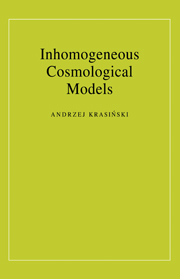Book contents
- Frontmatter
- Contents
- List of illustrations
- Preface
- Acknowledgements
- 1 Preliminaries
- 2 The Szekeres–Szafron family of solutions
- 3 Physics and cosmology in an inhomogeneous Universe
- 4 The Stephani–Barnes family of solutions
- 5 Solutions with null radiation
- 6 Solutions with a “stiff fluid”/scalar field source
- 7 Other solutions
- 8 Averaging out inhomogeneities of geometry and matter in cosmological models
- 9 Comments
- Appendix A Dictionary of abbreviations used in the text and in the diagrams
- Appendix B Why should one consider inhomogeneous models of the Universe?
- Appendix C Memorable statements about the cosmological principle
- Appendix D How was this review compiled?
- Appendix E Historical milestones
- Notes added in proof
- Bibliography
- Index
5 - Solutions with null radiation
Published online by Cambridge University Press: 03 May 2010
- Frontmatter
- Contents
- List of illustrations
- Preface
- Acknowledgements
- 1 Preliminaries
- 2 The Szekeres–Szafron family of solutions
- 3 Physics and cosmology in an inhomogeneous Universe
- 4 The Stephani–Barnes family of solutions
- 5 Solutions with null radiation
- 6 Solutions with a “stiff fluid”/scalar field source
- 7 Other solutions
- 8 Averaging out inhomogeneities of geometry and matter in cosmological models
- 9 Comments
- Appendix A Dictionary of abbreviations used in the text and in the diagrams
- Appendix B Why should one consider inhomogeneous models of the Universe?
- Appendix C Memorable statements about the cosmological principle
- Appendix D How was this review compiled?
- Appendix E Historical milestones
- Notes added in proof
- Bibliography
- Index
Summary
General remarks
In this chapter, we shall study a family of solutions which were constructed with the explicit aim of superposing the FLRW models with various important vacuum or electrovacuum solutions. They become the FLRW models in the homogeneous perfect fluid limit, and they reduce to the Kerr or related solutions in the stationary (electro-) vacuum limit. They were guessed rather than derived by integration of the Einstein equations. The null radiation in them was not introduced as an additional physical component of matter, but appeared ex post as a device to interpret those components of the Einstein tensor that do not belong to the perfect fluid or electromagnetic field. As a result, the various components of the source (the fluid, the electromagnetic field and the null radiation) are coupled through the parameters and functions that they all contain, and cannot be set to zero separately. Usually, setting the null radiation component to zero results in trivializing the other components automatically (for example, it may result in reducing the solution to a FLRW model or to a vacuum). This is a disadvantage, of course, but otherwise the solutions constitute a very interesting experiment in combining different models that has already reached remarkable sophistication and provided new insights into the properties of known solutions. The papers from this family do not contain sufficient information to assign the solutions to the Wainwright (1979 and 1981) classes. The solutions are displayed in Figure 5.1.
- Type
- Chapter
- Information
- Inhomogeneous Cosmological Models , pp. 195 - 214Publisher: Cambridge University PressPrint publication year: 1997

